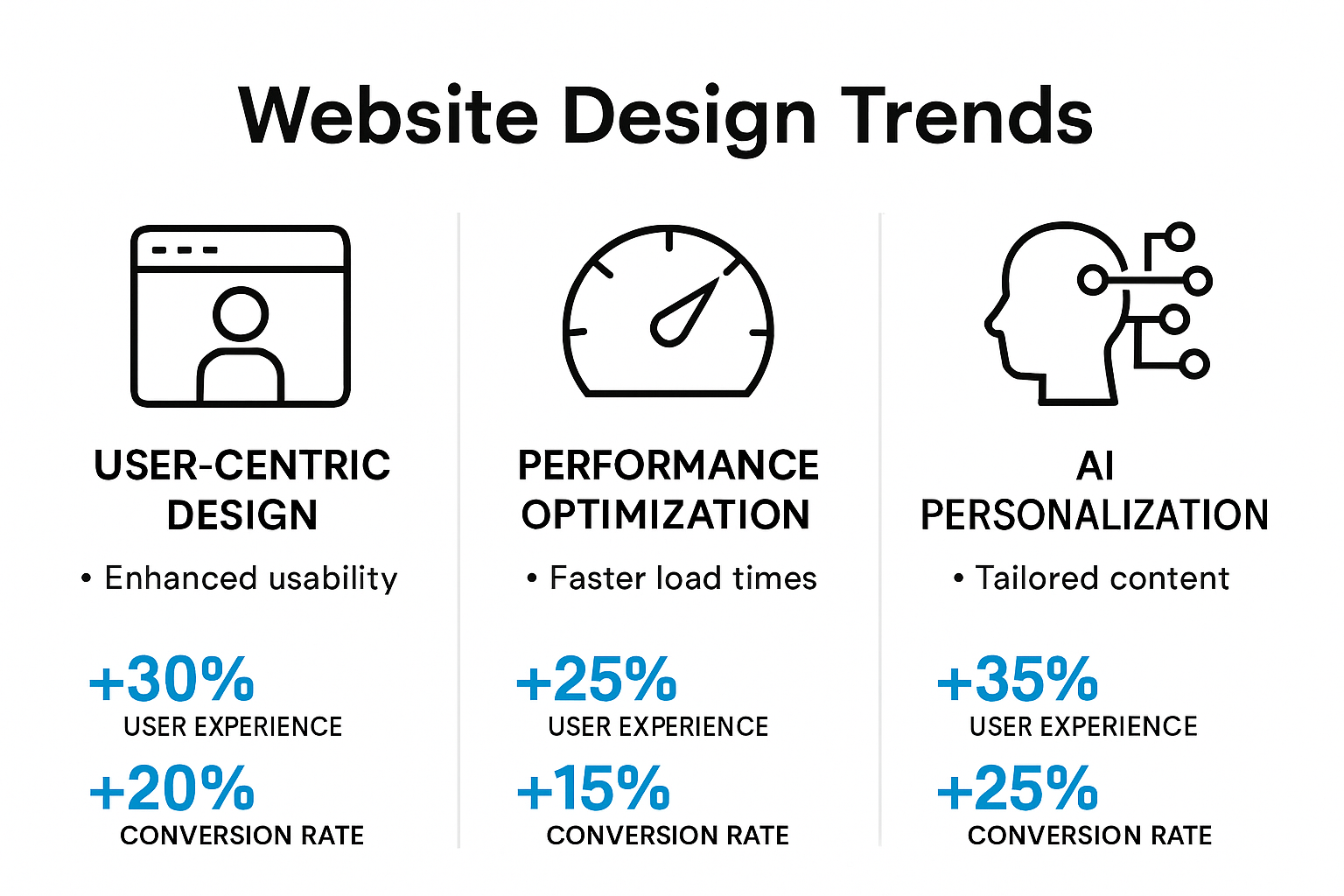Modern website design is doing a lot more than just making things look pretty online. Sites that focus on user experience can boost engagement rates by over 200 percent, which most people find mind-blowing. Most believe flashy visuals are at the heart of it all, but the real change comes from strategic choices that quietly shape how users think, feel, and act every time they click or scroll.
Table of Contents
- Key Elements Defining Modern Website Design Trends
- How Trends Improve User Experience and Conversion
- Integrating Modern Design with Advanced Technologies
- Choosing the Right Trends for Your Business
Quick Summary
| Takeaway | Explanation |
|---|---|
| Prioritize User-Centric Design | Focus on user experience to enhance engagement and retention. Ensure inclusivity and accessibility in all design elements. |
| Optimize for Performance | Ensure your website loads quickly and functions seamlessly across devices to build user trust and satisfaction. |
| Leverage AI for Personalization | Use AI technologies to tailor user experiences, enhancing engagement through dynamic content and recommendations. |
| Evaluate Trends Strategically | Assess web design trends based on user utility, implementation cost, and alignment with your brand identity. |
| Manage Risks of Innovation | Adopt new design elements incrementally to test effectiveness without jeopardizing existing digital infrastructure. |
Key Elements Defining Modern Website Design Trends
Modern website design transcends mere visual aesthetics. It represents a strategic approach to digital presence that combines user experience, technological innovation, and business objectives. The evolution of web design reflects a complex interplay between emerging technologies, user expectations, and organisational goals.
To help you quickly compare and understand the core principles shaping modern website design, here’s a concise summary of key elements and what they deliver:
| Key Element | Focus/Description | Business Benefit |
|---|---|---|
| User-Centric Design | Emphasises user needs, accessibility, and inclusivity | Enhanced engagement, broader reach |
| Performance & Technical Excellence | Mobile-first, responsive layouts, fast loading, cross-platform compatibility | Improved trust, reduced bounce rate |
| Strategic Visual Communication | Uses consistent typography, colour, and hierarchy to guide users and reinforce branding | Strong brand identity, clearer messaging |
User-Centric Design Principles
At the core of contemporary web design lies an unwavering commitment to user experience. According to Coursera’s design trends analysis, micro-animations and freehand illustrations are transforming static interfaces into dynamic, engaging experiences. These subtle design elements create emotional connections with users, making digital interactions more intuitive and memorable.
Accessibility has become a critical consideration. Modern design must accommodate diverse user needs, ensuring that websites are usable across different devices, abilities, and cultural backgrounds. This approach goes beyond compliance - it represents a fundamental shift towards inclusive digital experiences.
Performance and Technical Excellence
Technical performance is no longer optional but essential. The Illinois Department of Innovation & Technology emphasises the critical importance of mobile-first design and touch-optimised interfaces. Websites must load rapidly, respond seamlessly across devices, and provide consistent functionality whether accessed via smartphone, tablet, or desktop.
Key technical considerations include:
- Responsive Design: Fluid layouts that adapt dynamically to screen sizes
- Performance Optimization: Minimising load times and maximising computational efficiency
- Cross-Platform Compatibility: Ensuring consistent user experience across different devices and browsers
Strategic Visual Communication
Modern web design is a sophisticated communication tool. Typography, colour schemes, and visual hierarchies are carefully orchestrated to convey brand identity and guide user interactions. Erie Institute of Technology highlights the importance of consistent typography and strategic visual elements that reinforce brand messaging.
Businesses are increasingly recognising that their website is often the first point of digital engagement. As such, design must balance aesthetic appeal with clear, purposeful communication. Learn more about crafting exceptional digital experiences in our comprehensive guide to user experience design.
The landscape of web design continues to evolve, driven by technological innovation, changing user expectations, and the need for businesses to differentiate themselves in an increasingly digital marketplace. Success lies not just in following trends, but in understanding the deeper strategic implications of design choices.
How Trends Improve User Experience and Conversion
In the digital ecosystem, website design is not merely about visual appeal but a strategic instrument for driving business growth and enhancing user engagement. Modern design trends are increasingly focused on creating seamless, intuitive experiences that directly impact user behaviour and conversion rates.
Psychological Engagement Through Design
Design elements go far beyond aesthetic considerations. According to research from the National Institutes of Health, strategic website aesthetics can significantly influence user psychology and decision-making processes. Minimalist designs with clean layouts and purposeful visual hierarchies reduce cognitive load, enabling users to navigate and comprehend information more efficiently.

Key psychological design principles include:
- Visual Clarity: Reducing complexity to enhance user understanding
- Emotional Resonance: Creating design elements that evoke positive user feelings
- Intuitive Navigation: Guiding users seamlessly through digital experiences
Conversion-Focused Design Strategies
Conversion is the ultimate metric for digital success. Modern web design trends are meticulously crafted to transform passive website visitors into active participants. Techniques like strategic colour psychology, strategic placement of call-to-action buttons, and personalised user journeys are becoming increasingly sophisticated.
Businesses must understand that every design choice communicates something. Colour schemes, typography, and interactive elements are not decorative but strategic communication tools. For deeper insights into building brand credibility through design, explore our comprehensive guide on conversion optimization.
Performance and User Trust
Website performance is intrinsically linked to user trust and conversion potential. Slow-loading pages, complicated navigation, or non-responsive designs can immediately erode user confidence. Modern design trends prioritise:
- Rapid page load times
- Seamless mobile responsiveness
- Consistent and predictable user interactions
These technical considerations are not secondary but fundamental to creating positive user experiences. A well-designed website communicates professionalism, reliability, and user-centricity.

Ultimately, successful digital experiences are created by understanding user needs, anticipating their expectations, and delivering value through thoughtful, strategic design. The most effective websites are those that make complex interactions feel effortless and intuitive.
Integrating Modern Design with Advanced Technologies
The intersection of modern website design and advanced technologies represents a transformative approach to digital experiences. Businesses are no longer merely creating websites but developing sophisticated digital ecosystems that dynamically respond to user needs and technological capabilities.
Artificial Intelligence and Personalization
According to research from the Association for Computing Machinery, artificial intelligence is revolutionising how websites interact with users. AI-driven technologies enable websites to create personalized experiences that adapt in real-time, delivering content, recommendations, and interfaces tailored to individual user preferences and behaviours.
Key AI integration strategies include:
- Dynamic Content Adaptation: Websites that modify layouts and content based on user interactions
- Predictive User Experiences: Anticipating user needs before they articulate them
- Intelligent Recommendations: Generating contextually relevant suggestions
Interactive Technologies and User Engagement
Research in Frontiers of Psychology highlights how interactive technologies profoundly impact user psychology and engagement. Advanced technologies like chatbots, augmented reality interfaces, and real-time data visualisation are transforming passive browsing into immersive, interactive experiences.
Businesses seeking to understand the foundational principles of these technological integrations can explore our comprehensive web development guide to gain deeper insights into emerging digital strategies.
Technological Infrastructure and Design Synergy
Successful integration of advanced technologies requires more than technical implementation. It demands a holistic approach where design aesthetics, technological capabilities, and user experience are harmoniously aligned. Modern websites must balance cutting-edge functionality with intuitive, accessible design.
This means developing technological infrastructures that are:
- Scalable and adaptable
- Security-focused
- Performance-optimised
- Capable of seamless cross-platform experiences
The future of web design lies not in technology for technology’s sake, but in creating meaningful, intelligent digital interactions that genuinely enhance human experiences. By thoughtfully integrating advanced technologies, businesses can create websites that are not just digital platforms, but dynamic, responsive ecosystems that grow and adapt with their users.
Choosing the Right Trends for Your Business
Selecting the appropriate web design trends is not about blindly following industry hype, but strategically aligning technological innovations with specific business objectives. The digital landscape offers numerous possibilities, but successful implementation requires careful, purposeful consideration.
Strategic Trend Evaluation
The Nielsen Norman Group emphasises that trend adoption must prioritise user experience and business goals over aesthetic novelty. Each design trend must be critically evaluated against three fundamental criteria: user utility, technical feasibility, and alignment with brand identity.
Businesses should systematically assess potential trends by considering:
- Functional Relevance: Does the trend solve a genuine user or business problem?
- Implementation Cost: What are the technical and financial investments required?
- Long-Term Sustainability: Will this trend remain valuable beyond current technological cycles?
Industry-Specific Trend Adaptation
Trend suitability varies dramatically across different industry sectors. What works brilliantly for an e-commerce platform might be inappropriate for a professional services website. Understanding your specific digital ecosystem is crucial.
For example, a financial services firm might prioritise clean, trust-inducing designs with robust security indicators, while a creative agency could experiment with more dynamic, interactive interfaces. Context is key in determining which design trends genuinely enhance user experience.
Risk Management in Digital Innovation
Adopting new design trends involves calculated risk. Businesses must maintain a balance between innovation and stability. Incremental implementation allows for testing and refinement without compromising entire digital infrastructure.
Consider starting with smaller, controlled experiments. Explore our comprehensive digital strategy guide for insights into managing technological transitions effectively.
To highlight practical risk-management when applying new web design trends, here’s a checklist table to guide your approach as outlined in the article:
| Action Step | Recommended Approach | Purpose/Benefit |
|---|---|---|
| Evaluate functional relevance | Yes | Ensures trends meet real user/business needs |
| Assess implementation cost | Yes | Determines technical and financial feasibility |
| Check long-term sustainability | Yes | Avoids short-lived, costly changes |
| Start with incremental experiments | Yes | Minimises risk and allows for adjustments |
| Balance innovation and stability | Yes | Protects core digital infrastructure |
Successful trend integration is not about wholesale transformation but strategic, measured evolution. By maintaining a user-centric approach, businesses can leverage design trends as powerful tools for digital differentiation and growth. The most effective websites are those that use technology to solve real problems, not simply to appear cutting-edge.
Frequently Asked Questions
What are the key elements of modern website design?
Modern website design focuses on user-centric design, performance and technical excellence, and strategic visual communication. These elements work together to enhance user experience and drive business growth.
How can website design impact user engagement rates?
By prioritizing user experience through intuitive navigation, fast loading times, and accessibility features, websites can boost engagement rates by over 200%. Effective design creates emotional connections with users, making their interactions more enjoyable and memorable.
What role does artificial intelligence play in modern website design?
Artificial intelligence enhances website design by enabling personalized user experiences. It can dynamically adapt content and layouts based on individual user interactions, providing tailored recommendations and improving overall engagement.
How should businesses evaluate which design trends to implement?
Businesses should assess design trends based on functional relevance to user needs, implementation costs, and long-term sustainability. It’s essential to ensure that new trends align with the brand’s identity and goals before full adoption.
Transform Modern Web Trends Into Real Business Growth
Reading about the latest web design trends can feel exciting, but knowing how to put those insights to work for your business often leaves a gap. If you are facing the challenges mentioned in the article—such as achieving faster loading times, guiding your clients with seamless user journeys, or making your site truly mobile-first and user-centric—you are not alone. Many South African companies struggle to translate new design ideas into lasting business results, especially when it comes to balancing performance, intuitive experiences, and a unique visual identity.
This is exactly where Cloudfusion steps in. Our full-service team brings those key concepts like accessibility, strategic visual communication, and AI-driven personalisation from theory straight into practice. Whether you want a website that adapts effortlessly across devices or crave smarter, scalable solutions tailored to your industry, we are here to help you turn trends into real performance gains. See how our custom web design and development service can help your business thrive, or revisit the user experience design guide for inspiration on your next move. Ready to chat to an expert about driving measurable growth through modern website design? Get started today by visiting Cloudfusion—let’s build your advantage while your competitors are still catching up.








